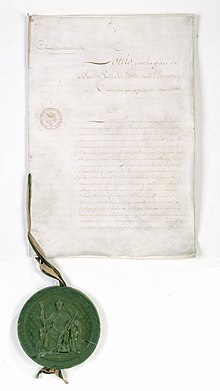
Back Carta de 1814 Catalan Charte constitutionnelle German Χάρτα του 1814 Greek Ĉarto de 1814 Esperanto Carta de 1814 Spanish 1814ko eskutitza Basque Vuoden 1814 peruskirja Finnish Charte constitutionnelle de 1814 French 1814 का घोषणा पत्र Hindi Carta francese del 1814 Italian
This article includes a list of general references, but it lacks sufficient corresponding inline citations. (June 2022) |
| Charter of 1814 | |
|---|---|
 Charter of 1814. | |
| Original title | (in French) Charte constitutionnelle du 4 juin 1814 |
The French Charter of 1814 was a constitutional text granted by King Louis XVIII of France shortly after the Bourbon Restoration, in form of royal charter. The Congress of Vienna demanded that Louis bring in a constitution of some form before he was restored. After refusing the proposed constitution, the Constitution sénatoriale, set forth on 6 April 1814 by the provisional government and the Sénat conservateur ("Conservative Senate"), Louis Stanislas Xavier, count of Provence, bestowed a different constitutional Charter, on 4 June 1814. With the Congress of Vienna's demands met, the count of Provence was officially named Louis XVIII, and the monarchy was restored.
The Charter presents itself as a text of compromise, possibly of forgiveness, preserving the numerous acquisitions from the French Revolution and the Empire, whilst restoring the dynasty of the Bourbons. Its title as ‘constitutional Charter’ acts as evidence of compromise, the term ‘charter’ as reference to the Ancien Régime (“old rule”) and ‘constitutional’ indicates revolutionary intent. However, the Charter establishes a limited monarchy, as opposed to a constitutional monarchy, implementing a regime dominated by the King himself, declaring him as Head of State.